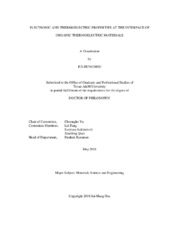| dc.contributor.advisor | Yu, Choongho | |
| dc.creator | Hsu, Jui-Hung | |
| dc.date.accessioned | 2019-01-17T18:52:16Z | |
| dc.date.available | 2020-05-01T06:24:33Z | |
| dc.date.created | 2018-05 | |
| dc.date.issued | 2018-04-30 | |
| dc.date.submitted | May 2018 | |
| dc.identifier.uri | https://hdl.handle.net/1969.1/173511 | |
| dc.description.abstract | Composites made of poly(3,4-ethylenedioxythiophene):poly(styrenesulfonate) (PEDOT:PSS) and carbon nanotube (CNT) have shown unchanged or even increased thermopower when electrical conductivity was raised by altering the concentration of CNT and/or treating the composites with a polar solvent, dimethyl sulfoxide (DMSO) or an acid, formic acid (FA). In this study, an intermediate CNT concentration showed the highest thermopower and power factor unlike other typical reports with organic composites. The origin of the unusual transport properties was suggested by studying changes in the relative ratio of conducting PEDOT core and insulating PSS, morphology, and carrier concentration and mobility. Our results indicate that the PSS removal by DMSO and FA could alter the carrier transport barrier, and CNT-PEDOT junctions could increase thermopower for composites with a low CNT concentration by avoiding direct contacts between CNTs. For further studying the role of energy barrier at the junctions, organic electrochemical transistor (OECT) was employed as a vehicle to modulate relative energy levels of PEDOT and CNT. By constructing the band diagram at the junction with HOMO, LUMO, and Fermi levels determined by CV, KPFM, and UPS with and without applying gate voltage, the correlation between electrical and thermoelectric properties and the energy barrier height was established. An optimized power factor of 1047 μW/m-K^2 was obtained with a 15 V gate voltage and 0.27 eV energy barrier. The improvement of power factor was attributed to the enhancement of thermopower due to energy filtering effect with minimally affected electrical conductivity. Further, devices with 1 through 8 CNT-PEDOT junctions were fabricated with barrier height fine-tuned through hydrazine reduction to the optimized condition (0.27 eV). A promising power factor of up to 1299 μW/m-K^2 was obtained with a device with 6 junctions. | en |
| dc.format.mimetype | application/pdf | |
| dc.language.iso | en | |
| dc.subject | thermoelectric | en |
| dc.subject | carbon nanotube | en |
| dc.subject | PEDOT:PSS | en |
| dc.subject | nanocomposite | en |
| dc.subject | chemical treatment | en |
| dc.subject | energy filtering | en |
| dc.subject | organic electrochemical transistor | en |
| dc.title | Electronic and Thermoelectric Properties at the Interface of Organic Thermoelectric Materials | en |
| dc.type | Thesis | en |
| thesis.degree.department | Materials Science and Engineering | en |
| thesis.degree.discipline | Materials Science and Engineering | en |
| thesis.degree.grantor | Texas A & M University | en |
| thesis.degree.name | Doctor of Philosophy | en |
| thesis.degree.level | Doctoral | en |
| dc.contributor.committeeMember | Fang, Lei | |
| dc.contributor.committeeMember | Sukhishvili, Svetlana | |
| dc.contributor.committeeMember | Qian, Xiaofeng | |
| dc.type.material | text | en |
| dc.date.updated | 2019-01-17T18:52:17Z | |
| local.embargo.terms | 2020-05-01 | |
| local.etdauthor.orcid | 0000-0003-4321-4693 | |


